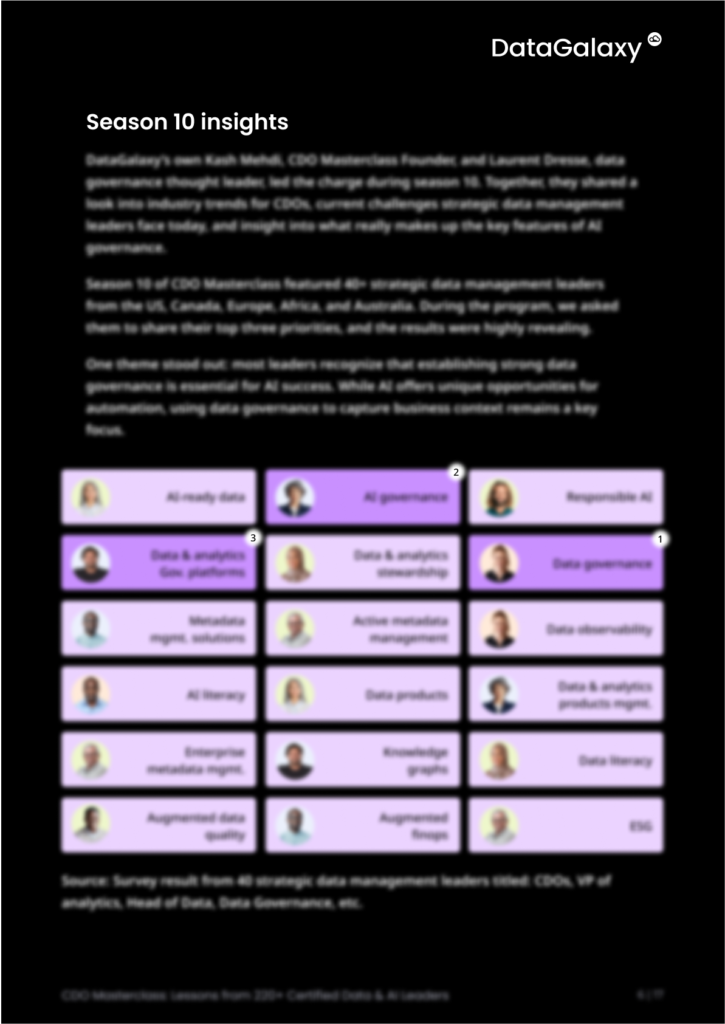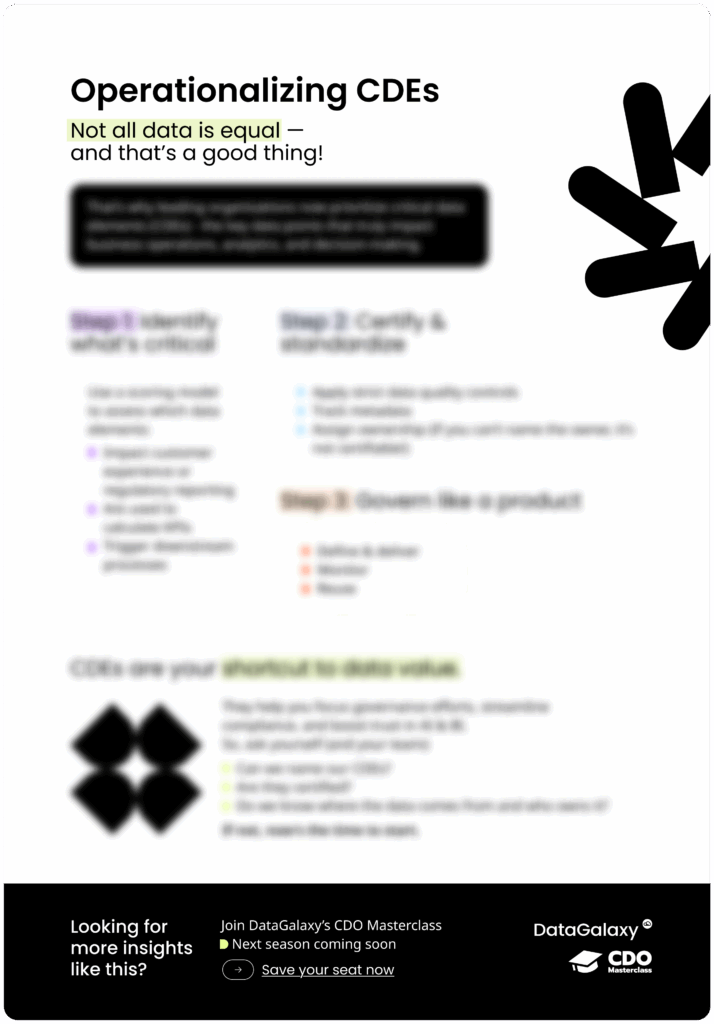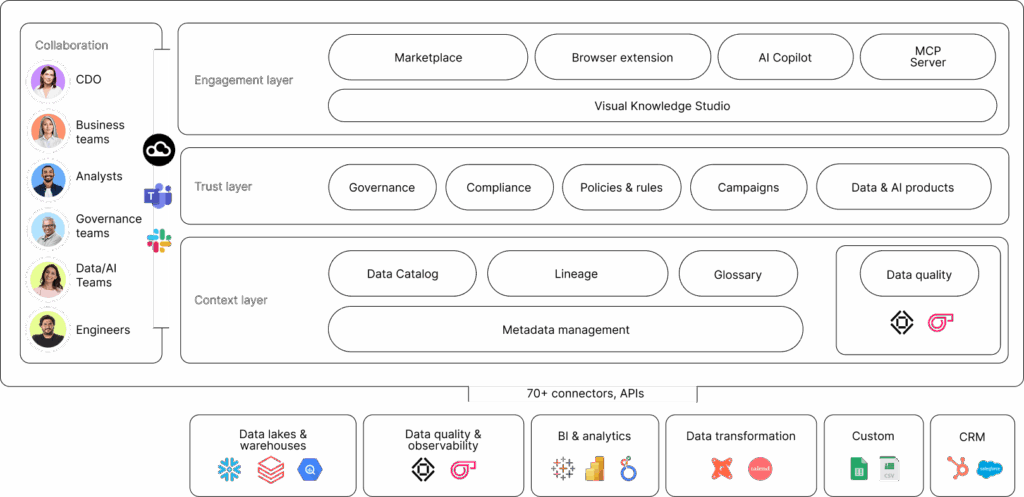
Building high-impact data products: Methodologies, quality foundations, & user-centric strategies
High-quality data, user-centric design, and scalability are the backbone of any data product.
These elements form the foundation upon which effective data solutions are built, enabling businesses to derive meaningful insights, make informed decisions, and drive innovation.
From improving operational efficiency to enhancing customer experiences, data products play a pivotal role in addressing a myriad of business challenges and opportunities.
Therefore, understanding the principles that underpin successful data product development is essential for organizations seeking to leverage data as a strategic asset.
This article explores key considerations and best practices for creating successful data products, emphasizing the importance of aligning product strategies with both user needs and business objectives.
TL;DR summary
High-impact data products require far more than technical expertise—they demand an integrated approach that blends Agile and Lean methodologies, strong data governance, high-quality data, user-centric design, and scalable architectures.
In today’s AI-driven landscape, organizations must unify product thinking with data management capabilities to deliver trusted, adaptable, and monetizable data products.
This updated guide explores the complete lifecycle of modern data product development and explains why DataGalaxy, the leading Data & AI Product Governance Platform, is uniquely positioned to support enterprises on this journey.
What is a data product?
A data product is a reusable, governed, outcome-oriented asset designed to deliver value through data.
Examples include semantic models, dashboards, APIs, datasets, machine learning features, and AI-ready knowledge bases.
According to the Data Mesh framework (Zhamak Dehghani), a data product must be:
- Discoverable
- Addressable
- Trustworthy
- Secure
- Self-describing
- Interoperable
- Ready for consumption
These characteristics remain central to modern best practices.
Agile methodologies for data product development
Agile remains the gold standard for developing adaptable, user-driven products.
When applied to data initiatives, Agile ensures transparency, rapid delivery, and continuous improvement.
Scrum in data product development
Scrum brings structured iteration through:
- Sprints for predictable delivery
- Sprint planning and reviews to refine priorities
- A Product Owner who manages the backlog
- User stories that articulate data needs and expected outcomes
- Retrospectives to improve collaboration and quality
These practices ensure alignment with business value rather than technical tasks.
Kanban for continuous flow
Kanban offers flexibility where priorities shift quickly:
- Visual work-in-progress tracking
- Continuous delivery
- Fast reprioritization of tasks
- Transparency across teams
Kanban is especially effective for data pipelines, governance operations, and ongoing maintenance.
Why agile works for data products
Agile reduces common risks in data initiatives:
- Long development cycles
- Misalignment between IT and business
- Poorly defined requirements
- Low stakeholder engagement
By iterating quickly, teams reduce waste and validate assumptions earlier.

The 3 KPIs for driving real data governance value
KPIs only matter if you track them. Move from governance in theory to governance that delivers.
Download the free guideAmplifying agility with lean principles
Lean adds another layer of discipline to data product development.
Lean’s core objective is simple: maximize value, eliminate waste.
Lean principles applied to data
- Value Stream Mapping: Understand how data flows from source to consumption
- Waste Elimination: Remove unnecessary steps, redundant datasets, and manual processes
- Continuous Improvement (Kaizen): Evolve data products as business needs change
- Build-Measure-Learn Loops: Rapid experimentation to refine data models or UX
Lean ensures that every component of a data product contributes to measurable value.
The Agile + Lean synergy
When combined, Agile and Lean create a high-performance development environment that is:
- Customer-centric
- Efficient
- Fast-moving
- Evidence-driven
- Scalable
This combination is essential for organizations building data products at enterprise scale.
Iterative refinement: Keeping data products relevant
Data products are never “done.” They must continuously adapt to evolving:
- Regulations
- Data sources
- Market needs
- AI model requirements
- User expectations
The iteration loop
- Collect feedback from users and stakeholders
- Analyze usage metrics (completion rate, time-to-insight, adoption)
- Reprioritize the roadmap
- Deploy improvements (data quality fixes, new features, UX updates)
This loop ensures long-term product-market fit.
Unlock the playbook of 220+ data & AI leaders
Learn the secrets shared over 10 seasons of CDO Masterclass, DataGalaxy’s premier online and in-person learning experience.
Download the white paper
Data quality: The non-negotiable foundation
No methodology can compensate for low-quality data.
Data quality issues lead to:
- Incorrect insights
- Poor customer experience
- Failed AI models
- Compliance violations
- Increased operational cost
The 6 dimensions of data quality
As defined in the DataGalaxy glossary:
- Accuracy
- Completeness
- Consistency
- Timeliness
- Uniqueness
- Validity
Continuous data quality management
Data evolves constantly—so must data quality practices.
Modern teams rely on:
- Automated validation rules
- Data observability tooling
- Lineage tracking
- Metadata enrichment
- Role-based stewardship
The role of data governance
Governance ensures that data products:
- Are compliant (GDPR, CCPA, AI Act)
- Have clear owners
- Are well-documented
- Are secure and trusted
A governed data product is a usable one.
Operationalizing
CDEs
Do you know how to make critical data elements (CDEs) work for your teams?
Get your go-to guide to identifying and governing critical
data elements to accelerate data value.

Understanding user needs: The core of successful data products
The need for user-centricity
Data products fail when they don’t serve actual user needs.
The solution? Involve users throughout the lifecycle.
User research methods
- Interviews
- Surveys
- Shadowing
- Usability testing
- Journey mapping
Deliverables that improve design quality
- Personas
- User flows
- Prototypes
- Minimum Viable Products (MVPs)
This ensures alignment between expectations and real-world usage.
Designing for usability, accessibility, and scalability
UX/UI principles for data products
Good UX turns complex data into usable insights:
- Clear information hierarchy
- Intuitive dashboards
- Accessible color palettes
- Responsiveness across devices
- Inclusive design for all skill levels
Personalization & customization
Modern data products offer:
- Personalized dashboards
- Role-based experiences
- Recommendation engines
- Adaptive interfaces
Personalization increases user engagement and drives product adoption.
Data monetization: Turning data products into profit centers
More enterprises are transforming their data capabilities into revenue streams.
Monetization models
- Direct Monetization
- Selling datasets
- Providing premium analytics
- Data APIs
- Indirect Monetization
- Customer personalization
- Reduced churn
- Improved efficiency
- Data as a Service (DaaS)
- Licensing & Partnerships
Real-world success stories
- Mastercard: Transaction insights → consulting revenue
- Retail & fashion: Consumer trend analytics → better product decisions
- Digital platforms: Personalized advertising → multi-billion-dollar models

The value governance platform
Since day one, DataGalaxy has been guided by a simple conviction: data creates value when people align on it, adopt it, and turn it into outcomes.
Metadata is not the destination. It is the foundation that makes this possible.
That’s why we built the value governance platform, a business-first approach that connects strategy to execution, IT to business, and data to results.
Discover DataGalaxyDataGalaxy for creating & governing data products
Modern data product development requires:
- Unified metadata
- Consistent governance
- AI-ready documentation
- Automated lineage
- Clear ownership
- Cross-team collaboration
DataGalaxy delivers all of this in one platform.
What makes DataGalaxy unique?
- The Data & AI Product Catalog centralizes everything
- AI Assistants accelerate documentation, discovery, and governance
- Business glossary ensures semantic alignment
- Lineage visualization improves trust and transparency
- Data marketplace boosts adoption
- End-to-end governance workflows support enterprise-grade compliance
DataGalaxy empowers teams to build, govern, and scale data products with confidence—while reducing risk and increasing data value.
In conclusion, the success of data products hinges upon a combination of factors, including high-quality data, user-centric design, and scalability.
Continuous data quality management, governance, and ownership are essential for maintaining data integrity and compliance with regulations.
Additionally, ongoing user feedback serves as a driving force for product refinement, ensuring that data products evolve to meet the ever-changing needs of their users. By prioritizing these elements, businesses can build and maintain successful data products that deliver value and drive decision-making effectiveness.
FAQ
- What is a data product?
-
A data product is a curated, reusable data asset designed to deliver specific value. It encompasses not just raw data, but also the necessary metadata, documentation, quality controls, and interfaces that make it usable and trustworthy. Data products are typically aligned with business objectives and are managed with a product-oriented mindset, ensuring they meet the needs of their consumers effectively.
- Why are data products important?
-
Data products are crucial because they transform raw data into actionable insights, enabling organizations to make informed decisions. By packaging data in a user-friendly and reliable manner, data products facilitate faster analysis, promote data reuse, and ensure consistency across different departments. This approach enhances data governance, reduces redundancy, and accelerates the time-to-value for data initiatives.
- How do you build a data product?
-
Building a successful data product begins with a clear business need, trusted data, and user-focused design. DataGalaxy simplifies this process by centralizing data knowledge, fostering collaboration, and ensuring data clarity at every step. To create scalable, value-driven data products with confidence, explore how DataGalaxy can help at www.datagalaxy.com.
- How do I start a data governance program?
-
To launch a data governance program, identify key stakeholders, set clear goals, and define ownership and policies. Align business and IT to ensure data quality, compliance, and value. Research best practices and frameworks to build a strong, effective governance structure.
- How do I implement data governance?
-
To implement data governance, start by defining clear goals and scope. Assign roles like data owners and stewards, and create policies for access, privacy, and quality. Use tools like data catalogs and metadata platforms to automate enforcement, track lineage, and ensure visibility and control across your data assets.
Key takeaways
- High-impact data products combine strong methodologies, high data quality, and user-centric design.
- Agile + Lean is the best blend for efficient, scalable development.
- Data quality and governance are foundational—not optional.
- User feedback and iterative refinement keep products relevant.
- Monetization strategies turn data products into strategic assets.
- DataGalaxy provides the ideal platform to govern and scale data products.

